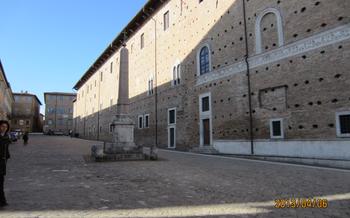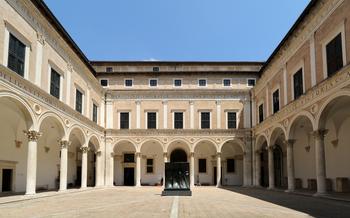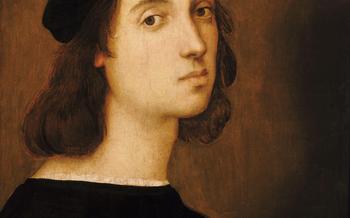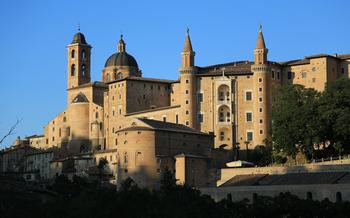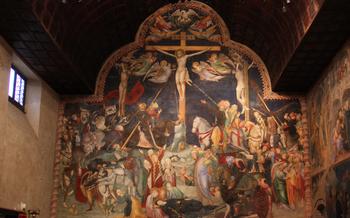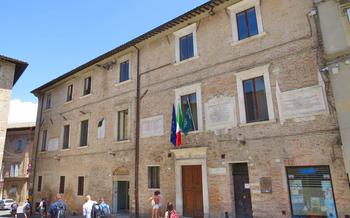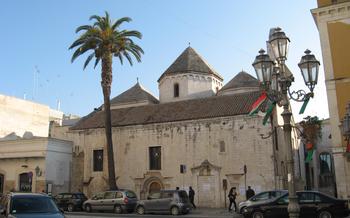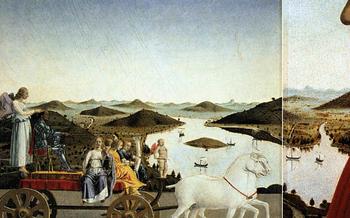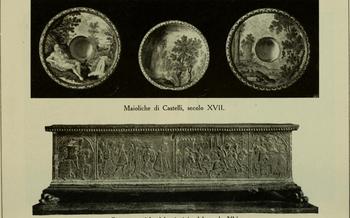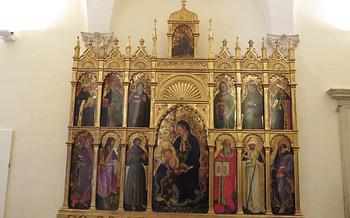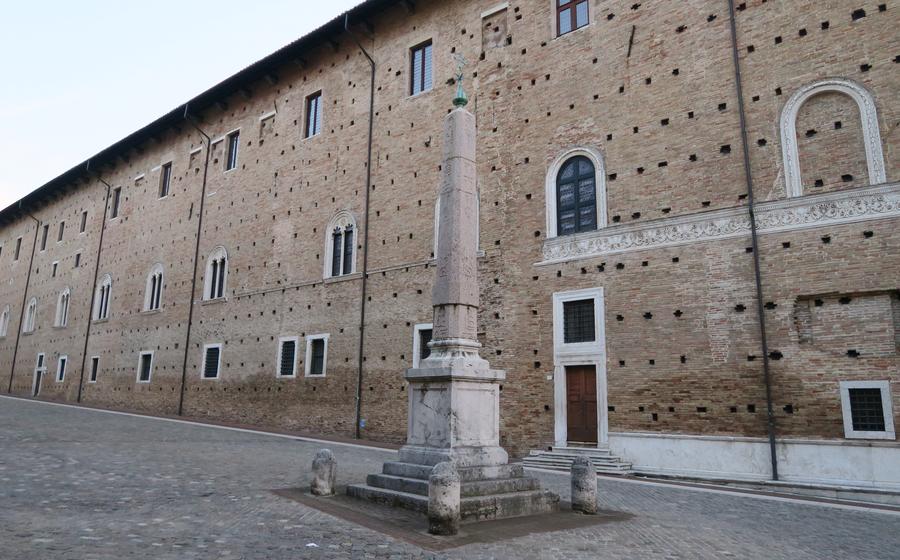
Oratory of Sant'Angelo
- The Oratory of Sant'Angelo: A Masterpiece in Urbino's Cultural Tapestry
- Historical Context
- Architectural Marvel
- The Oratory's Interior: A Treasury of Artistic Delights
- Federico Barocci's Masterpiece
- Storytelling Through Frescoes
- Symbolism and Iconography
- Restoration and Preservation
- Visiting the Oratory
- Local Insight
- Cultural Events and Exhibitions
- Suggested Itineraries
- Photography Tips
The Oratory of Sant'Angelo: A Masterpiece in Urbino's Cultural Tapestry
In the heart of Urbino, nestled amidst the medieval streets and Renaissance palaces, lies a hidden gem waiting to be discovered: the Oratory of Sant'Angelo. This architectural wonder, dating back to the 15th century, stands as a testament to the city's rich artistic heritage and the influence of the powerful Dukes of Urbino. With its stunning frescoes, intricate carvings, and captivating history, the Oratory of Sant'Angelo offers visitors a journey through time, immersing them in the splendor of Renaissance art and spirituality.
History and Background
The Oratory of Sant'Angelo was commissioned by Duke Federico da Montefeltro in the mid-15th century and completed during the reign of his son, Guidobaldo da Montefeltro. The oratory was initially conceived as a private chapel for the ducal family and was later opened to the public for religious services and devotion. The construction of the oratory coincided with Urbino's golden age, when the city was a thriving center of arts, culture, and learning under the patronage of the Montefeltro dynasty.
Architectural Style
The Oratory of Sant'Angelo showcases a harmonious blend of architectural styles, reflecting the transition from the Gothic to the Renaissance period. The exterior features a simple yet elegant façade with a pointed arch portal and a rose window. The interior boasts a spacious rectangular layout with a barrel-vaulted ceiling, adorned with intricate stucco decorations and ribbed arches. The overall design exudes a sense of serenity and balance, creating an ideal space for contemplation and prayer.
Location and Accessibility
The Oratory of Sant'Angelo is conveniently located in the historic center of Urbino, just a short walk from the Ducal Palace and the Piazza del Rinascimento. Its central position makes it easily accessible for visitors exploring the city's main attractions. The oratory is open to the public during specific hours, and guided tours are available upon request, offering a deeper insight into its history and artistic significance.
Interesting Facts
-
The Oratory of Sant'Angelo is believed to have been built on the site of a Roman temple dedicated to the god Hercules.
-
The oratory houses the remains of Duke Federico da Montefeltro and his wife, Battista Sforza, in a beautifully sculpted tomb by Francesco di Giorgio Martini.
-
The oratory was used as a meeting place for the Confraternity of Sant'Angelo, a religious brotherhood founded by the Montefeltro family.
-
The oratory underwent extensive restoration work in the 19th and 20th centuries to preserve its precious frescoes and architectural elements.
Historical Context
The Oratory of Sant'Angelo was constructed between 1482 and 1491 under the patronage of Giovanni di Pierfrancesco della Rovere, the second Duke of Urbino. The oratory was part of a larger complex that included a hospital and a confraternity, which provided assistance to the sick and needy.
The oratory's construction was a testament to the growing power and influence of the Dukes of Urbino, who were among the most prominent patrons of the arts in Renaissance Italy. The oratory was designed to celebrate the ducal family and to showcase their wealth and piety. It was also intended to serve as a place of worship and contemplation for the members of the confraternity.
The oratory's historical significance is further enhanced by its association with Federico da Montefeltro, one of the most illustrious Dukes of Urbino and a renowned military leader and patron of the arts. Federico was a close friend and patron of Piero della Francesca, one of the most important painters of the Renaissance. Piero's famous painting, "The Flagellation of Christ," was originally commissioned for the oratory, but it is now housed in the Uffizi Gallery in Florence.
Architectural Marvel
The Oratory of Sant'Angelo showcases a captivating blend of architectural styles that harmoniously coexist within its sacred space. Its exterior facade exudes a sense of simplicity and elegance, characterized by smooth stone walls adorned with intricate carvings around the portal and window frames. The main entrance, set within a rectangular frame, features a graceful arch supported by slender columns, hinting at the artistic treasures that lie within.
Stepping inside the oratory, visitors are greeted by an awe-inspiring interior that seamlessly integrates Gothic and Renaissance elements. The rectangular plan of the building is divided into two naves by a row of slender columns topped with elegant capitals. The nave on the left leads to the main altar, while the one on the right features a series of side altars dedicated to various saints.
The oratory's interior is a testament to the exceptional craftsmanship of the artisans who created it. The ribbed vaults spanning the ceiling display intricate patterns and converge at ornate keystones, adding depth and visual interest to the space. The walls are adorned with a series of niches and pilasters that frame the frescoes and sculptures, creating a dynamic and visually engaging environment.
Notable architectural elements include the intricately carved pulpit, crafted from white marble and featuring delicate reliefs depicting biblical scenes. The main altar, with its elaborate baldachin supported by twisted columns, serves as a focal point for the oratory's interior. Its ornate decoration and gilded details reflect the wealth and power of the Dukes of Urbino who commissioned the oratory.
Overall, the architectural design of the Oratory of Sant'Angelo reflects the transition from the Gothic style, prevalent in the city during the Middle Ages, to the emerging Renaissance style that would later dominate the artistic landscape of Italy.
The Oratory's Interior: A Treasury of Artistic Delights
Step inside the Oratory of Sant'Angelo, and you will be greeted by a symphony of artistic wonders that captivate the senses. Every inch of the interior is adorned with intricate frescoes, sculptures, carvings, and decorative elements that blend harmoniously to create a breathtaking visual spectacle.
The oratory's ceiling is a canvas for Federico Barocci's stunning frescoes, which depict scenes from the Old and New Testaments with remarkable detail and expressiveness. Gaze upon the vibrant colors, graceful figures, and dramatic compositions that bring biblical narratives to life.
The walls of the oratory are adorned with sculptures and carvings of saints, angels, and biblical figures, each meticulously crafted to exude a sense of piety and reverence. The altarpiece, a masterpiece in itself, features a delicate marble relief depicting the Madonna and Child surrounded by a chorus of angels.
Natural light streams through the stained glass windows, casting a warm glow upon the interior and illuminating the intricate details of the frescoes and sculptures. Each window tells a story, portraying biblical scenes or the lives of saints, adding another layer of depth and symbolism to the oratory's sacred space.
Federico Barocci's Masterpiece
Among the oratory's many treasures, the fresco cycle by Federico Barocci stands out as a masterpiece of Renaissance art. Barocci, a renowned painter of the late 16th century, was commissioned by the confraternity of Sant'Angelo to decorate the oratory's walls and ceiling with a series of frescoes depicting scenes from the Old and New Testaments.
Barocci's frescoes are not only visually stunning but also deeply meaningful. They showcase his mastery of perspective, color, and light, creating a sense of depth and realism that was groundbreaking for his time. The scenes he depicted are rich in symbolism and theological depth, inviting viewers to contemplate the profound messages embedded within.
Barocci's artistic style is characterized by its elegance, grace, and emotional intensity. His figures are depicted with a sense of movement and drama, their faces expressing a wide range of emotions. The colors he used are vibrant and harmonious, creating a sense of luminosity that further enhances the impact of his compositions.
Barocci's frescoes in the Oratory of Sant'Angelo represent a significant contribution to Renaissance art. They not only demonstrate his exceptional skill as a painter but also reflect the profound religious and cultural beliefs of his time. These frescoes continue to captivate and inspire viewers to this day, solidifying Barocci's legacy as one of the most influential artists of the Italian Renaissance.
Storytelling Through Frescoes
The Oratory of Sant'Angelo's frescoes are not mere decorations; they are profound visual narratives that transport viewers into the realm of biblical stories and theological teachings. Federico Barocci's brushstrokes bring to life scenes from both the Old and New Testaments, inviting Betrachtern to engage with the spiritual and moral lessons embedded within.
In the Old Testament scenes, Barocci portrays the creation of the world, the fall of Adam and Eve, and the story of Moses leading the Israelites out of Egypt. These episodes serve as reminders of humanity's origins, struggles, and divine deliverance. The New Testament frescoes, on the other hand, depict the life of Jesus Christ, from his birth to his resurrection. These scenes encapsulate the central tenets of Christianity, emphasizing themes of redemption, sacrifice, and eternal life.
Beyond the explicit biblical narratives, Barocci's frescoes are also rich in symbolic and allegorical elements. Each scene is imbued with hidden meanings and references to Christian theology. The dove, for instance, represents the Holy Spirit, while the serpent symbolizes temptation and evil. By deciphering these visual clues, viewers gain a deeper understanding of the frescoes' spiritual significance.
The Oratory of Sant'Angelo's frescoes are not just artistic masterpieces; they are powerful tools for storytelling and spiritual contemplation. Barocci's masterful brushwork and profound theological insights invite Betrachtern to embark on a visual journey that transcends time and space, leaving them with a lasting sense of awe and inspiration.
Symbolism and Iconography
Beyond their aesthetic appeal, the frescoes in the Oratory of Sant'Angelo carry profound symbolic and iconographic meanings. Each scene is imbued with Christian symbolism, allegorical figures, Biblical references, and artistic symbolism that invite deeper contemplation and understanding.
Christian Symbolism:
The frescoes are replete with Christian symbols, reinforcing the religious significance of the oratory. The lamb, a symbol of Christ's sacrificial love, appears in various scenes. The dove, representing the Holy Spirit, is depicted in delicate flight. The cross, a reminder of Christ's crucifixion and resurrection, is prominently displayed. These symbols serve as visual reminders of the core beliefs and teachings of Christianity.
Allegorical Figures:
Allegorical figures, personifying abstract concepts, are skillfully woven into the frescoes. Justice, depicted as a blindfolded woman holding scales, emphasizes the importance of fairness and impartiality. Prudence, represented by a two-faced figure holding a mirror and a snake, symbolizes wisdom and foresight. These figures add depth and complexity to the narratives, inviting viewers to contemplate their allegorical meanings.
Biblical References:
The frescoes draw inspiration from both the Old and New Testaments, creating a cohesive narrative of salvation history. Scenes from the Old Testament, such as the creation of Adam and Eve and the sacrifice of Isaac, prefigure the events of the New Testament. New Testament scenes, including the Annunciation, the Nativity, and the Crucifixion, depict the fulfillment of God's redemptive plan. These Biblical references ground the frescoes in the broader context of Scripture, enhancing their theological significance.
Artistic Symbolism:
Barocci masterfully employs artistic symbolism to convey complex ideas and emotions. Color plays a crucial role, with vibrant hues representing divine attributes and spiritual qualities. Light and shadow create a sense of depth and drama, highlighting the emotional intensity of the scenes. Gestures and expressions convey the inner thoughts and emotions of the figures, inviting viewers to connect with the narratives on a deeper level.
Deciphering the symbolism and iconography of the frescoes in the Oratory of Sant'Angelo offers a profound and enriching experience, revealing the hidden depths of meaning embedded within these remarkable works of art.
Restoration and Preservation
The Oratory of Sant'Angelo has undergone several restoration and preservation projects throughout its history to ensure the longevity of its precious frescoes and architectural features. These efforts have been crucial in safeguarding this cultural treasure for future generations.
One of the major challenges in restoring the oratory has been combating the effects of time, environmental factors, and past interventions. The delicate frescoes have been particularly vulnerable to humidity, temperature fluctuations, and exposure to light. Conservators have employed specialized techniques, such as fresco transfer and retouching, to carefully repair and restore the damaged areas while maintaining the original integrity of the artwork.
To preserve the oratory's structural integrity, experts have also addressed issues with the building's foundation and roof. Careful reinforcement and stabilization work have been carried out to prevent further deterioration and ensure the stability of the structure.
The importance of preserving the Oratory of Sant'Angelo cannot be overstated. It serves as a testament to the artistic brilliance of Federico Barocci and the cultural heritage of Urbino. Ongoing restoration projects and conservation efforts guarantee that this exceptional oratory continues to captivate visitors and inspire generations to come.
Visiting the Oratory
To fully appreciate the splendor of the Oratory of Sant'Angelo, it is essential to plan your visit carefully. The oratory is generally open to the public from Tuesday to Sunday, with specific hours varying depending on the season and special events. Admission fees are minimal and often include a guided tour, which is highly recommended to gain a comprehensive understanding of the oratory's history, architecture, and artistic significance.
Guided tours are available in multiple languages and can be booked in advance or arranged on-site. For those with limited mobility, the oratory is wheelchair accessible, ensuring that everyone can experience its awe-inspiring beauty. Remember to bring a camera to capture the stunning frescoes and architectural details, but be mindful of any restrictions on photography to preserve the integrity of this sacred space. Whether you're an art enthusiast, a history buff, or simply seeking a spiritual retreat, the Oratory of Sant'Angelo promises an unforgettable and enriching experience.
Local Insight
To delve deeper into the rich history and cultural significance of the Oratory of Sant'Angelo, it's essential to tap into the knowledge of local experts and historians. Their unique perspectives offer a deeper understanding and appreciation of this remarkable site.
Interviews with Scholars: Engaging in conversations with scholars specializing in Urbino's art and history provides invaluable insights into the oratory's construction, artistic influences, and symbolism. Their expertise sheds light on the historical context and the significance of the frescoes within the broader framework of Renaissance art.
Historical Anecdotes: Local historians often possess a wealth of intriguing anecdotes and stories related to the oratory. These tales bring the past to life, revealing the human stories behind the construction and patronage of this sacred space. Visitors can discover the fascinating personalities and events that shaped the oratory's legacy.
Local Folklore and Legends: The oratory is deeply embedded in the local folklore and legends of Urbino. These stories, passed down through generations, offer a glimpse into the popular imagination and the spiritual significance of the site to the local community. Exploring these legends provides a deeper connection to the cultural heritage of Urbino.
By engaging with local experts and historians, visitors can gain a deeper understanding of the Oratory of Sant'Angelo, its historical context, and its enduring significance within the cultural tapestry of Urbino.
Cultural Events and Exhibitions
The Oratory of Sant'Angelo is not just a historical and architectural treasure; it also serves as a vibrant cultural venue. Throughout the year, the oratory hosts a variety of events and exhibitions that showcase the rich artistic and cultural heritage of Urbino.
Art exhibitions featuring contemporary and historical works are held regularly, allowing visitors to admire the creations of talented local and international artists. The oratory's intimate atmosphere provides a unique setting for these exhibitions, creating a dialogue between past and present.
Concerts and musical performances are another highlight of the oratory's cultural calendar. The acoustics of the oratory enhance the experience of live music, making it an ideal venue for classical concerts, choral performances, and intimate musical gatherings.
Historical reenactments and cultural workshops are also organized within the oratory, offering visitors an immersive journey into the past. These events bring to life the history of the oratory and Urbino, providing a glimpse into the traditions, customs, and daily life of the Renaissance era.
Suggested Itineraries
Incorporating a visit to the Oratory of Sant'Angelo into your exploration of Urbino's cultural treasures can be a rewarding experience. Here are a few suggested itineraries to help you plan your time in this enchanting city:
One-Day Itinerary:
- Start your day with a stroll through Urbino's historic center, admiring the medieval architecture and vibrant atmosphere.
- Visit the Ducal Palace of Urbino, a UNESCO World Heritage Site, and immerse yourself in the splendor of its Renaissance art and architecture.
- Take a break for lunch at one of the many traditional restaurants in the city, savoring the flavors of regional cuisine.
- In the afternoon, visit the Oratory of Sant'Angelo to witness Federico Barocci's stunning fresco cycle.
- Conclude your day with a leisurely walk along the city walls, enjoying panoramic views of the surrounding countryside.
Two-Day Itinerary:
- On your second day, explore the National Gallery of Marche, home to a remarkable collection of Renaissance and Baroque paintings, including works by Piero della Francesca, Raphael, and Titian.
- Visit the Raphael's House and Museum to gain insights into the life and work of one of the most celebrated artists of the Renaissance.
- In the afternoon, take a guided tour of the Oratory of Sant'Angelo to learn more about its history, architecture, and symbolism.
- End your day with a visit to the San Francesco Church, where you can admire its elegant Gothic architecture and beautiful frescoes.
Multi-Day Itinerary:
- If you have more time, consider extending your stay in Urbino to explore its surrounding areas.
- Visit the nearby towns of Gubbio and Fabriano, each with its unique charm and cultural attractions.
- Take a day trip to the Montefeltro region, where you can visit picturesque hilltop villages and immerse yourself in the region's rich history and traditions.
No matter the length of your stay, Urbino offers a wealth of cultural experiences that will captivate history buffs, art enthusiasts, and travelers seeking an authentic Italian adventure.
Photography Tips
To capture the essence and beauty of the Oratory of Sant'Angelo through photography, consider these tips:
-
Lighting Conditions: Visit during the golden hours, around sunrise or sunset, when the natural light casts a warm and ethereal glow on the oratory's exterior. For interior shots, utilize the natural light filtering through the stained glass windows to create dramatic effects.
-
Camera Settings: Use a tripod to ensure stability and avoid camera shake, especially when shooting in low-light conditions. Set your camera to a low ISO to minimize noise and maintain image quality.
-
Composition and Perspective: Experiment with different angles and perspectives to create dynamic compositions. Capture the oratory's grandeur by shooting from a low angle, emphasizing its height and architectural details.
-
Editing and Post-Processing: Use post-processing software to enhance the colors and contrast of your images, bringing out the vibrant hues of the frescoes and the intricate details of the carvings.
